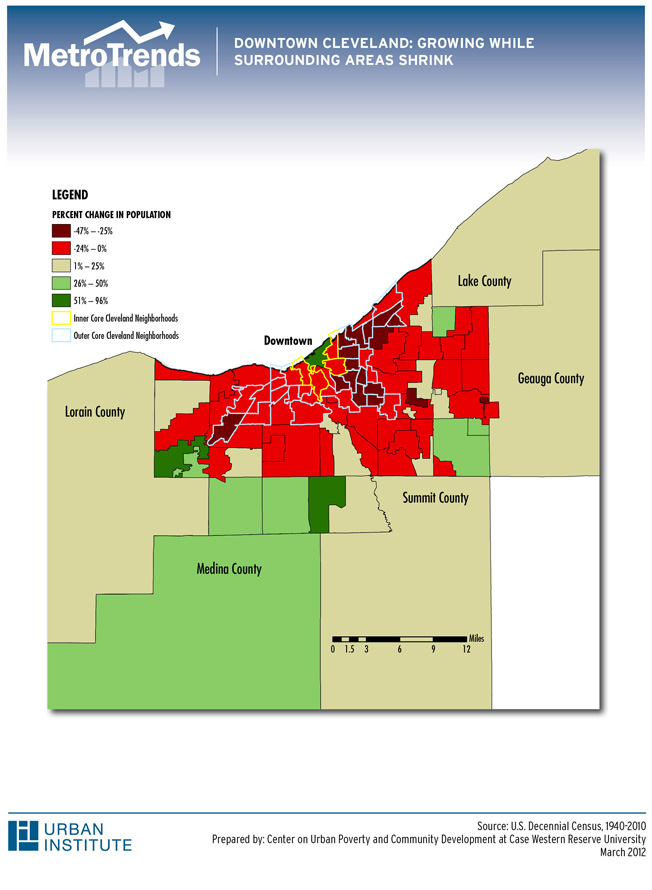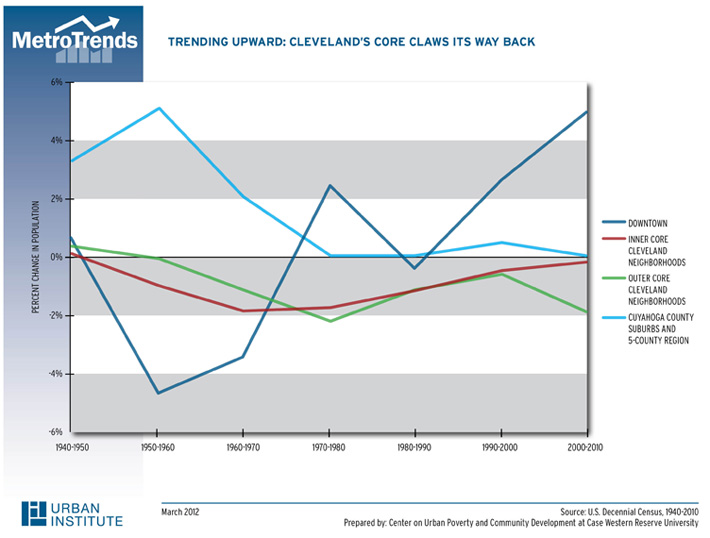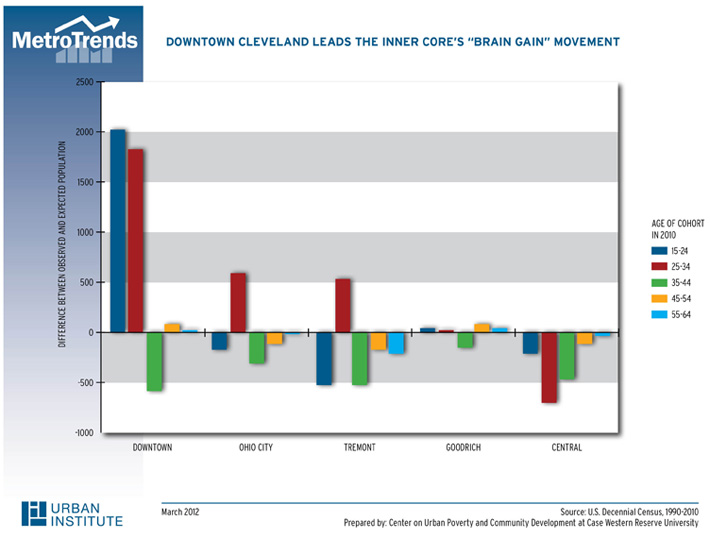
|
|
Metropolitan Spotlights Our metropolitan spotlights focus on selected metros, showing how they're faring relative to others in their region and nationally. Not Dead Yet: The Infill of Cleveland's Urban CoreMark Twain once said the "report of my death was an exaggeration". Perhaps the same thing can be said about the City of Cleveland. While Cleveland's struggles are real, there are signs of a revival, particularly in Cleveland's downtown district. Moreover, select neighborhoods on the periphery of downtown are also showing signs of vitality. And while time will tell if the city is filling in its donut hole so to speak, the fact remains: there is a pulse. Take the latest population figures in the 5 county metropolitan area. From 1990 to 2010, the City of Cleveland shrank, as did many of the suburban areas of Cuyahoga County. The growth mostly occurred in the increasingly exurban fringes of the metro, as well as on the edges of Cuyahoga County. Except there is one outlier: downtown Cleveland. Over the last two decades, the neighborhood's population grew 96%, with residential totals increasing from 4,651 to 9,098. It was the single largest spike of any neighborhood, suburb, or county measured for the two decades under study. Downtown residential occupancy rates now stand over 95% and developers are eagerly looking to meet residential demand. Historical analysis reveals that these trends have long been underway (see above). Before 1970, flight from the city accompanied growth in the suburbs and surrounding counties. By 1990, however, rapid growth began to materialize in downtown Cleveland. Moreover, population declines in Cleveland's inner core neighborhoods (see map for reference) bordering downtown began to slow. Between 1990 and 2000, these inner core neighborhoods broke with trends found in both outer core neighborhoods - where population loss hastens - as well in the suburban/exurban areas where population growth slows or begins to decline. But questions remain. Are fewer people leaving the neighborhoods bordering downtown or are folks moving in? If it is the latter, are the inner core neighborhoods being "pulled up" by demographic shifts mirroring downtown's growth? Put simply: is a reverse in the donut hole in the making? The answer is a (tentative) yes. An observed/expected analysis, performed by comparing the size of 10-year age cohort in 2000 (expected) and to its size in 2010 (observed), reveals that Cleveland's downtown re-densification may be spilling over into the adjacent inner core neighborhoods. In downtown, there has been a remarkable jump in the size of the cohort falling between the ages of 15 to 24 in 2010. The majority of this group is made up of 22 to 24-year olds (51%), whereas 15 to 17-year olds make up only 4%. This 22 to 24-year old influx bumps up against the substantial increase also found in the 25 to 34-year old cohort. In all, this could foretell a turning point for Cleveland, since it is those areas attracting the "young and the restless" (as this cohort has been dubbed) that will be best positioned in an evolving knowledge-based economy. Trends in other inner core neighborhoods are not as clear cut. In Ohio City and Tremont-two of Cleveland's gentrifying neighborhoods-the net inmigration of 25-34 year olds mirrors the pattern downtown (The term "gentrification" is used with pause in the Rust Belt, especially given the dearth of cheap housing that has resulted from an oversupply across the whole of the region's inner cities). Given that the Cleveland metro is losing its 25 to 34-year old cohort overall, evidence points to a core resurgence as opposed to a regional trend. That said, not all inner core neighborhoods are experiencing the same pattern. Goodrich/Kirtland Park, a near east side neighborhood, has not seen much inmigration and Central-Cleveland's poorest neighborhood with a poverty rate of over 70%-is losing population across the board. In other words, the reverse of the donut hole is tilted towards the west side of the map, which speaks to the legacy of segregation in Cleveland that still casts its shadow on the city. Another point of interest deals with the decline of the 2010 35 to 44-year old cohort. The exodus of the child-rearing age group may neutralize the gains made with the young. Be it because of school quality or safety concerns, this group's unwillingness to stay in either downtown or inner-tier neighborhoods gives pause to policymakers and politicians alike. So what does it all mean for Cleveland? Well, in terms of policy, there are generally two schools of thought. The first focuses on retaining middle-aged people leaving the region by encouraging the growing 25 to 34-year cohort to "age in place" so as to catalyze school and community improvements that will make the inner core more family friendly. The second school of thought involves letting the older cohort "go" in order to make space for the younger "brain gain" group. For proponents of the so-called "churn model", such as Jim Russell, an expert on migration and economic development, the issue isn't so much the inability to retain so long as there is a constant influx of fresh ideas and talent taking place. Said Russell, when presented with the Cleveland migration data: "the suburban/exurban migration of the older cohort will speed up revitalization and make the young adults more dominant in Downtown, Ohio City, and Tremont. The urban core is a net importer of young adults and a net exporter of old adults. That's the antithesis of a dying city." Cleveland-the antithesis of a dying city? Quite possibly. |
Share
Feedback Metropolitan Spotlights Related Resources |






